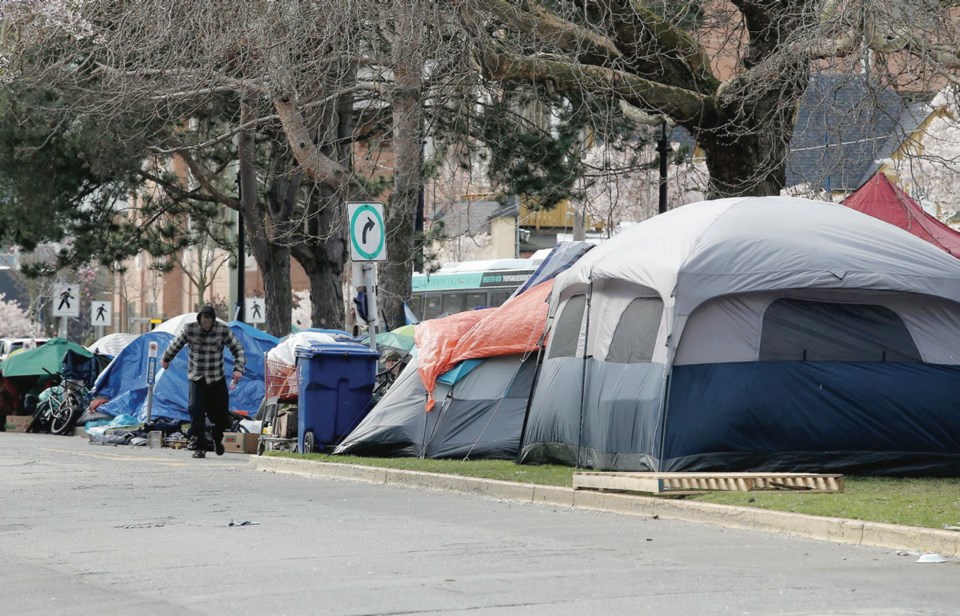Years ago, while walking down Douglas Street, I spotted a panhandler with a sign that read: ŌĆ£Alcohol Research In Progress. Please Help.ŌĆØ
I was amused, thinking to myself: ŌĆ£YouŌĆÖre sitting on the sidewalk begging for money for booze. How much more evidence do you need before you conclude your research.ŌĆØ
Tragically, that beggarŌĆÖs situation is not all that dis-similar to that of Victoria council, which finds itself now begging the province to force hoteliers to open their doors to house homeless people ŌĆö many of whom are now camping on Pandora Avenue.
The city says there are few other options. The vast number of people now sleeping rough in Topaz Park and on city boulevards such as Pandora is evidence, it says, of the scope of the homelessness problem in the capital region.
And it is.
Shelters have had to close or are practising social distancing, which has forced many homeless previously hidden onto the streets.
But all of those tents also speak to the huge mental-health/addictions problem in the region (indeed some argue the untreated addictions and mental-health problem is the cause of the housing problem) and the decades-long expectation that with ever-expanding harm-reduction initiatives, it will go away.
We have been following this harm-reduction model for drug addiction ŌĆö the idea that rather than trying to treat addiction we can manage it ŌĆö for more than 20 years. Maybe itŌĆÖs time we ask: ŌĆ£How much more evidence do we need?ŌĆØ
By now, everyone should be familiar with the concept of harm reduction. After all, the social isolation and social distancing weŌĆÖve been practising for the past month to lessen the spread of COVID-19 is a form of harm reduction.
By definition, harm reduction involves any number of public health policies that are designed to lessen the negative social and/or physical consequences associated with a variety of behaviours, both legal and illegal.
Victoria has been a pioneer with harm-reduction initiatives aimed at drug use. One of the first needle-exchange programs in the country was opened here. Since, harm-reduction initiatives have expanded to include not only the distribution of clean drug use supplies, but to the distribution of the overdose-reversing drug Naloxone and the opening of supervised consumption sites where people can inject their own illicit drugs.
Opioid substitution drugs are now widely prescribed and there are increasingly louder cries for government to provide ŌĆ£safeŌĆØ drugs to addicts whose illicit supplies are likely contaminated with the more powerful fentanyl.
Indeed, Housing First is considered a harm-reduction initiative, the thinking being that itŌĆÖs near impossible to help people with substance or mental-health problems unless they first have a roof over their heads.
There is nothing wrong with any of that, and there is no question that lives have been saved through harm-reduction initiatives.
The problem is that harm reduction was always intended to be one pillar in a four-pillar strategy to address addiction. The other three are education, enforcement and treatment. Over the past two decades, virtually all of the resources have gone into harm reduction and virtually nothing has gone into the other three. On 91įŁ┤┤ Island, some would argue, access to treatment has gotten worse.
So here we are. The 900 block of Pandora has gone from what was already a shit-show into an even bigger shit-show. Officials are rightly concerned about the population down there. And they should be. Forget social distancing, people down there are sharing drugs and cigarettes.
ItŌĆÖs a danger not only to them, but to motorists passing by, worried about someone darting out into the street. People walking in the area have a right to be worried about their health. If the virus hits that population, it will be horrific.
Whether or not the province steps in, the city canŌĆÖt let this persist. Unfortunately, what was supposed to be harm reduction is now harm induction.
Years ago, because of a growing problem on Pandora, the city amended its bylaw specifically prohibiting tenting on boulevards. It should enforce it and reconsider opening up Royal Athletic Park and Beacon Hill Park to tenters ŌĆö properly distanced, of course.
Then the city will have to enforce its bylaw and tell people now squatting there thatŌĆÖs where they have to go if they need to tent.
When this COVID crisis is over, the province will have to reconsider whether the one-pillar approach to addiction is working ŌĆö or whether we have enough evidence after 20 years that it is not.
Bill Cleverley is a former Times 91įŁ┤┤ reporter who has been clean and sober since October 2002.



